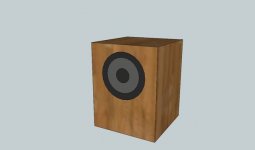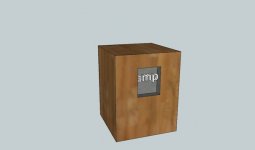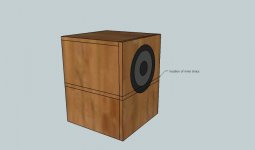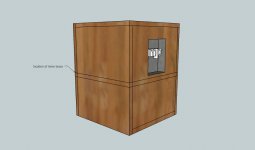Hey,
Dayton Audio RSS390HF-4 15" Reference HF Subwoofer 4 Ohm
This one is reference too. Only $30 more and 3" bigger. Good idea?
~Just noticed you pointed me to a much cheaper 15" dayton. How do they compare?
Revboden,
What roll-off do I want for my room (remember I'm more concerned about quality/detail than volume)? I realize perfection isn't an option, but what's my best bet?
And what do I want, 6dB roll-off or -6dB roll-off?
Should I just use this? good compromise? " That driver in a 8ft cube box would give a 8db roll off. max of 105db using 58 watts. "
It puts me a little over $300, but not too much.
Here's a picture of my room. I will have (furniture, not speakers) bookshelves up against the back of the sofa to close off the room more. That turns my room into 10x15 with a few gaps where there aren't book shelves. I could put up some sort of door if it helps a lot. I will carpet the floor, too. The desks will be turned into wall-braced counter tops with a soft material on top (and thus no legs).
The RSS390HF-4 is about 3db less effecient than the one I mentioned. It wil get louder but you need 110 more watts to get that 3-5db.
Most medium sized rooms will support about +6db of room gain (reflected energy) of low frequencies 20-40hz. so if you can get a sub with about -8db roll off you end up with -2db roll off, which won't really be noticed.
Something to think about when choosing an amp. Amps work very well when they can function between 30-60% rated rms power. Also, using a speaker that will give you 80-100db (or whatever your loudness preferences are) using only 30-60% of the amp will sound the cleanest. If you used the RSS390HF-4 you would get very similar sound to the less expensive sub at the same SPL or loudness. But the RSS390HF-4 will need 60-90% of the 100w amp to make the same amount of noise so you'd need a 250w amp to get back to the 30-60% range of an amp. If you don't need that extra 5db (104-109db) you're just spending money.
Last edited:
Rev, is this the one you're refering to? I went back and I can only find one driver you suggested.
Dayton Audio DCS380-4 15" Classic Subwoofer 4 Ohm
The other gent told me Not to use a 15", so now I don't know what to do.
If that's the one, what size box will I use to get -8dB?
Dayton Audio DCS380-4 15" Classic Subwoofer 4 Ohm
The other gent told me Not to use a 15", so now I don't know what to do.
If that's the one, what size box will I use to get -8dB?
I think the 12" is the better woofer, and you said at the outset that fidelity was more important than loudness. You will still use the cheaper amp, but otherwise you can follow the project as it's shown.
The cheaper amp doesn't seem to have the EQ, but you can cross that bridge when you get to it. It's basically an active filter tone control. I can probably provide a schematic should you need one.
Send PE an email or post to their forum of your intentions to build a "Drake Jr" and they'll no doubt help you get rolling.
The cheaper amp doesn't seem to have the EQ, but you can cross that bridge when you get to it. It's basically an active filter tone control. I can probably provide a schematic should you need one.
Send PE an email or post to their forum of your intentions to build a "Drake Jr" and they'll no doubt help you get rolling.
dB is a reference value. So what are we referencing? 8dB per octave? Starting where? I don't have a reference, so it isn't useful. Call me dummy.
Have a look at the graph again on the project page. It's reasonably flat from about 30Hz to 75Hz. This is a good thing. It's down 3dB at 28Hz and 80Hz. At 15Hz (1 octave from 30Hz) and 150Hz (1 octave from 75Hz) it's down more than 10dB. This is with the bass boost tweaking that he did.
You can design a different box. The project intentionally uses a smaller box. There's software that can calculate dimensions after you input driver parameters. Bigger box=more raw materials=more $. But you asked for a project, and that's what you got. Not trying to be too sarcastic, but if you had asked for something based on your specifications, I wouldn't have replied.
Have a look at the graph again on the project page. It's reasonably flat from about 30Hz to 75Hz. This is a good thing. It's down 3dB at 28Hz and 80Hz. At 15Hz (1 octave from 30Hz) and 150Hz (1 octave from 75Hz) it's down more than 10dB. This is with the bass boost tweaking that he did.
You can design a different box. The project intentionally uses a smaller box. There's software that can calculate dimensions after you input driver parameters. Bigger box=more raw materials=more $. But you asked for a project, and that's what you got. Not trying to be too sarcastic, but if you had asked for something based on your specifications, I wouldn't have replied.
You gave me what I asked for, Sofa..
I was also pursuing what Rev said,
"I think you'll find that people here start with the driver first. if you find a driver and amp, say: Dayton Audio DCS380-4 15" Classic Subwoofer 4 Ohm and Dayton Audio SA100 100W Subwoofer Amplifier , we'll happily tell you how large a box to build to get the roll-off you want."
~~
Thanks to both of you.
I was also pursuing what Rev said,
"I think you'll find that people here start with the driver first. if you find a driver and amp, say: Dayton Audio DCS380-4 15" Classic Subwoofer 4 Ohm and Dayton Audio SA100 100W Subwoofer Amplifier , we'll happily tell you how large a box to build to get the roll-off you want."
~~
Thanks to both of you.
We all seem to be guessing at room gain here.
If your room is perfectly sealed, you will get smooth room gain when 1/2 wavelength hits the longest room dimensions (apparently), the gain would be +12dB for every octave you go down.
Of course, your room isn't perfectly sealed, so how can we predict it's interaction now? A +6dB/octave boost may happen, but it's very unlikely, because of how unpredictable room interactions can be.
Personally, I'd aim for a flat alignment then play with eq when you can hear what it needs, rather than guessing at this stage.
Chris
If your room is perfectly sealed, you will get smooth room gain when 1/2 wavelength hits the longest room dimensions (apparently), the gain would be +12dB for every octave you go down.
Of course, your room isn't perfectly sealed, so how can we predict it's interaction now? A +6dB/octave boost may happen, but it's very unlikely, because of how unpredictable room interactions can be.
Personally, I'd aim for a flat alignment then play with eq when you can hear what it needs, rather than guessing at this stage.
Chris
Icor,
The speaker/amp I mentioned was just an example not a recommendation, sorry if I mislead you. If you like the 12" project at parts express go for it. If you want, I'll look up the speaker they used and give you a suggestion on box size that will give you a flatter response than the one in the project (the box in that project is too small to give flat response without active eq, and a lot of power).
How much space are you willing to dedicate to a speaker box? That's probably the first thing to think about.
You'll learn quickly that designing a sub is all about compromises.
The speaker/amp I mentioned was just an example not a recommendation, sorry if I mislead you. If you like the 12" project at parts express go for it. If you want, I'll look up the speaker they used and give you a suggestion on box size that will give you a flatter response than the one in the project (the box in that project is too small to give flat response without active eq, and a lot of power).
How much space are you willing to dedicate to a speaker box? That's probably the first thing to think about.
You'll learn quickly that designing a sub is all about compromises.
I'm having fun designing different subs for this application. I just came up with one I'm going to build for my shop. It's just for music.
Dayton Audio DCS305-4 12" with Dayton Audio SA100 100W Subwoofer Amplifier in a 3ft^3 sealed box half filled with fiberglass insulation. it will have about 7db roll off between 40hz and 20hz. and cost about 300$ everything included.
box: 18"X18"X23" od, with 18X23 side as the face with double thickness 3/4 baltic birch. one shelf brace splitting the long sides in half with nine 4" holes in it. insulation behind the shelf brace (away from the speaker)
build it if you want, it will sound good.
I'll post a cad drawing in a few moments.
Dayton Audio DCS305-4 12" with Dayton Audio SA100 100W Subwoofer Amplifier in a 3ft^3 sealed box half filled with fiberglass insulation. it will have about 7db roll off between 40hz and 20hz. and cost about 300$ everything included.
box: 18"X18"X23" od, with 18X23 side as the face with double thickness 3/4 baltic birch. one shelf brace splitting the long sides in half with nine 4" holes in it. insulation behind the shelf brace (away from the speaker)
build it if you want, it will sound good.
I'll post a cad drawing in a few moments.
By the way, if you want to get a little more fancy try using UnrealEditor. You can get it for free with Unreal Tournament 2004. It's a map editor, but I use it for CAD. Used it to design a few desks.  It's hard to learn, though. (I learned when I spent 120 hours building 1 map for a game.)
It's hard to learn, though. (I learned when I spent 120 hours building 1 map for a game.)
That's not an insult, yours looks fine. The other is more detailed if you wanted to learn, that's all.
That's not an insult, yours looks fine. The other is more detailed if you wanted to learn, that's all.
Last edited:
Nice, thanks!
What's the difference between that $75 sub you suggested and the reference HO (also 12") for $140?
You put the inner brace touching the subwoofer... won't that be really difficult to make?
the HO:
Specifications: * Power handling: 700 watts RMS/1200 watts max * VCdia: 2-1/2" * Le: 1.93 mH * Impedance: 4 ohms * Re: 3.4 ohms * Frequency range: 26 - 600 Hz * Fs: 32 Hz * Magnet weight: 150 oz. * SPL: 88 dB 2.83 V/1m, 85 dB 1W/1m * Vas: 1.18 cu. ft. * Qms: 4.27 * Qes: .45 * Qts: .41 * Xmax: 12.3mm *
Dimensions: A: 12-3/8", B: 11-1/8", C: 5-3/8".
the dcs305-4:
Specifications: • Power handling: 250 watts RMS/500 watts max • VCdia: 2-1/2" • Le: 1.94 mH • Impedance: 4 ohms • Re: 3.23 ohms • Frequency range: 23-200 Hz • Fs: 23 Hz • SPL: 89 dB 1W/1m •Vas: 4.12 cu. ft. • Qms: 5.59 • Qes: 0.44 • Qts: 0.41 • Xmax: 9.3 mm •
Dimensions: A: 12", B: 11", C: 6".
FS is the resonance of the speaker in free air. Speakers don't work very well below this frequency.
SPL is how efficient the speaker is with 1watt going into it.
Xmax is how far the speaker can move in one direction (in or out) from resting
basically the HO will get louder but needs much more power.
Last edited:
- Status
- This old topic is closed. If you want to reopen this topic, contact a moderator using the "Report Post" button.
- Home
- Loudspeakers
- Subwoofers
- Noob needing help.



